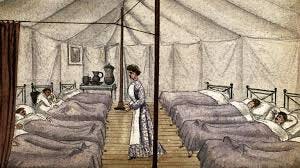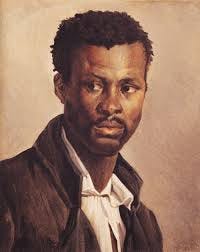
For centuries, human populations endured the harrowing scourge of smallpox, an affliction wrought by the variola virus. This merciless disease caused a relentless cycle of suffering, as its victims suffered with fever and a body wide rash that transformed into disfiguring, painful fluid-filled pustules. In a in an age of crude medical prescription, smallpox unleashed countless outbreaks and epidemics that often led to severe illness and death.
During the Age of Exploration in the late 15th and early 16th centuries, European explorers and settlers introduced smallpox and other infectious diseases to the Americas. The lack of immunity among the indigenous populations made them highly susceptible to these unfamiliar diseases, causing rapid and widespread outbreaks. As a result, smallpox and other illnesses had a profound impact on Native American communities, leading to significant loss of life and the decimation of entire populations.
But smallpox knew no nationality, age, or race. By the 1700s, the disease was a constant threat, and outbreaks occurred frequently, particularly in densely populated areas all over America. It spread rapidly through respiratory droplets, contaminated objects, or direct contact with an infected person. It affected people of all ages and backgrounds, and there was no specific treatment for the disease at that time.
The disease's devastating impact stemmed from its high mortality rates, along with survivors being afflicted with disfiguring scars or, in severe instances, blindness. Smallpox caused substantial death tolls and significantly influenced population dynamics.
No one knows the early origins of the enslaved man who landed in Boston in the early 1700s. Onesimus, as he came to be called, was believed to have been taken forcefully from his homeland in North or West Africa, forced into the bonds of slavery, and transported to the Massachusetts Bay colony aboard a ship. During that time, Massachusetts was a hub of the early slave trade in the United States and became the first American colony to legally establish the ownership of human beings in 1641. By the year 1700, approximately 1,000 enslaved individuals resided in Massachusetts.
The name Onesimus was not the original name given to him at birth. Similar to many others who experienced the horrors of slavery, historical texts only document the name he was given by his enslaver. The name Onesimus, meaning "useful," serves as a reminder of the property status imposed upon him by his enslaver.
In 1706, a church congregation in Boston acquired Onesimus through a purchase and subsequently "gifted" him to Cotton Mather, a well-known Puritan minister. You might recall the name Cotton Mather from your high school history lessons, particularly in relation to the Salem witch trials. Cotton Mather, being the son of Increase Mather, the founder of Harvard College, held significant influence as a Puritan minister and intellectual during that era. Cotton Mather, despite his prominent role, was also involved in the practice of enslavement.
The primary source of our knowledge regarding Onesimus stems from Cotton Mather's diary, supplemented by a few potential references found in subsequent church and civic records. What we can affirm with certainty is that he was an enslaved individual in Massachusetts by 1706. However, it remains unclear whether he was a recent arrival in North America or had been residing there for an extended period. There is strong evidence to that he was born in West Africa, as he had received smallpox inoculation during his childhood through a traditional West African method.
In a letter dated 1716 and addressed to the Royal Society of London, Cotton Mather recounted a discussion he had with Onesimus regarding smallpox. During that era, it was common for white individuals to inquire whether enslaved people had experienced the disease, as it was believed that those who had survived were deemed more valuable (as they were immune to further infection). When Mather posed the question to Onesimus about his exposure to smallpox, Onesimus responded with a somewhat enigmatic answer, saying, "Yes and no."
Onesimus proceeded to explain that during his childhood in Africa, he had undergone a procedure that provided him with a form of smallpox and granted him lifelong protection against the disease. He described the operation as involving the extraction of pus from an individual infected with smallpox, which was then scraped into his arm. This resulted in a mild case of the illness but bestowed upon him permanent immunity. Onesimus shared that this practice was commonplace within the African community in which he was raised and had been carried out for centuries.
The account Onesimus provided was known as variolation, an early method of inoculation employed to safeguard individuals against smallpox. Variolation, serving as a precursor to vaccination, had been practiced for many centuries in China, parts of Africa, and the Middle East. However, it remained relatively unfamiliar in England and the American colonies during the early 1700s. While variolation carried certain risks, it was regarded as significantly less lethal than contracting natural smallpox. Typically, it induced a mild form of smallpox, that granted lifelong immunity to it.
In 1721, half of Boston's residents were infected with smallpox, about 11,000 people. Cotton Mather, armed with the knowledge shared by Onesimus, embarked on a mission to safeguard the people of Boston during the subsequent smallpox epidemic in 1721. Mather became an advocate for the practice of variolation (referred to as smallpox inoculation at that time), yet encountered strong opposition from other white individuals residing in Boston.
Despite being highly esteemed in Massachusetts, only a solitary physician heeded Mather's audacious proposal. Zabdiel Boylston, one of the two doctors in Boston, placed trust in Cotton Mather and Onesimus regarding variolation. Boylston proceeded to inoculate his own son and the enslaved individuals laboring within his household. The reaction from other doctors and councilmen in the area was one of shock and horror.
Although some white Bostonians opposed variolation due to scientific uncertainty or religious reasons, a significant portion of the criticism arose from their racist perspective that undermined the valuable scientific knowledge possessed by African individuals. Detractors, including a prominent doctor, launched attacks on Cotton Mather, degrading his ideas as "Negroish" thinking.
William Douglas, the only other doctor in Boston at the time, joined forces with James Franklin, the older brother of Benjamin Franklin and a local newspaper proprietor, to initiate a racist disinformation campaign. They asserted that enslaved Africans were conspiring to harm their enslavers by deceiving them into infecting themselves with smallpox. Both Cotton Mather and Boylston, faced severe vilification for seeking medical guidance from an African individual. Douglas, in reference to Black people, made derogatory remarks stating, "There is not a Race of Men on Earth [filled with] more False Liars."
The opposition towards Mather's advocacy of inoculation even escalated to the extent of someone hurling an unexploded grenade through his window. This incident was an early precursor to anti-vaccination protests, as Bostonians took to the streets to express their opposition to Boylston's employment of smallpox inoculations for his son and two enslaved individuals.
Following the conclusion of the epidemic in 1722, Mather and Boylston conducted one of the earliest documented quantitative analyses in the field of medicine. Remarkably, Boylston managed to inoculate 280 individuals out of the city's population of 11,000. Among the inoculated group, only six individuals succumbed to the disease, accounting for a mere two percent mortality rate. In contrast, among the non-inoculated population, there were 6,000 reported cases of smallpox, resulting in the loss of 850 lives, translating to a 14 percent mortality rate. The results unequivocally demonstrated that individuals who underwent inoculation were seven times more likely to survive smallpox.
As a result of the successful experimentation with variolation, the practice gained wider acceptance in the colonies grappling with smallpox epidemics. In fact, in 1777, during a new smallpox outbreak amid the Revolutionary War, General George Washington took decisive action. Recognizing the value of science and technology and having personally experienced smallpox in his youth, Washington ensured that his entire army underwent inoculation to protect against the disease.
Because of this compelling evidence, inoculations became a widespread practice in Boston and across numerous states in the United States. However, their prevalence gradually diminished with the advent of a significant breakthrough in 1796. During that year, Edward Jenner developed the smallpox vaccine utilizing the cowpox virus. As the mid-1800s approached, variolation was phased out and replaced by immunization through cowpox, as it proved to be a safer and more effective method of safeguarding against smallpox.
For decades, the prevailing narrative surrounding these events exalted Mather and Boylston as heroes while relegating Onesimus and his African homeland to the background. The clinical analysis of a new medical treatment and the incorporation of of knowledge from an African enslaved individual were undoubtedly notable. However, these men had complex legacies beyond their accomplishments. For instance, Boylston actively enforced the inoculation procedure on two individuals he owned as slaves, thereby perpetuating the longstanding tradition of using Black bodies in medical experiments without their consent.
Following his purchase of freedom, Onesimus gradually disappeared from public records after 1716. The specifics of his journey and how he lived the remainder of his life remain largely undisclosed. Nevertheless, the impact of his contribution to the understanding of smallpox and its prevention continues to resonate in modern times.
Onesimus made significant contributions to the field of science. Despite enduring captivity and bondage, he played a crucial role in raising awareness about the effectiveness of variolation in the United States. His contributions directly contributed to one of the earliest scientific studies in medicine conducted in the country and, ultimately, paved the way for the development of the smallpox vaccine.
What Onesimus thought about his pivotal role in saving countless lives in the United States may forever remain a mystery. Nonetheless, his remarkable legacy stands tall, particularly considering that in 1980, the World Health Organization officially declared the eradication of smallpox from the world. This achievement is of tremendous significance, as smallpox, one of the deadliest and most dreaded diseases in human history, was vanquished thanks to the vaccine's impact.
Onesimus’story illustrates the degree to which reputable men of science depended on the testimony & experience of Africans in dealing with a dreaded disease.
Resources
https://www.history.com/news/smallpox-vaccine-onesimus-slave-cotton-mather
https://www.washingtonpost.com/history/2020/12/15/enslaved-african-smallpox-vaccine-coronavirus/








